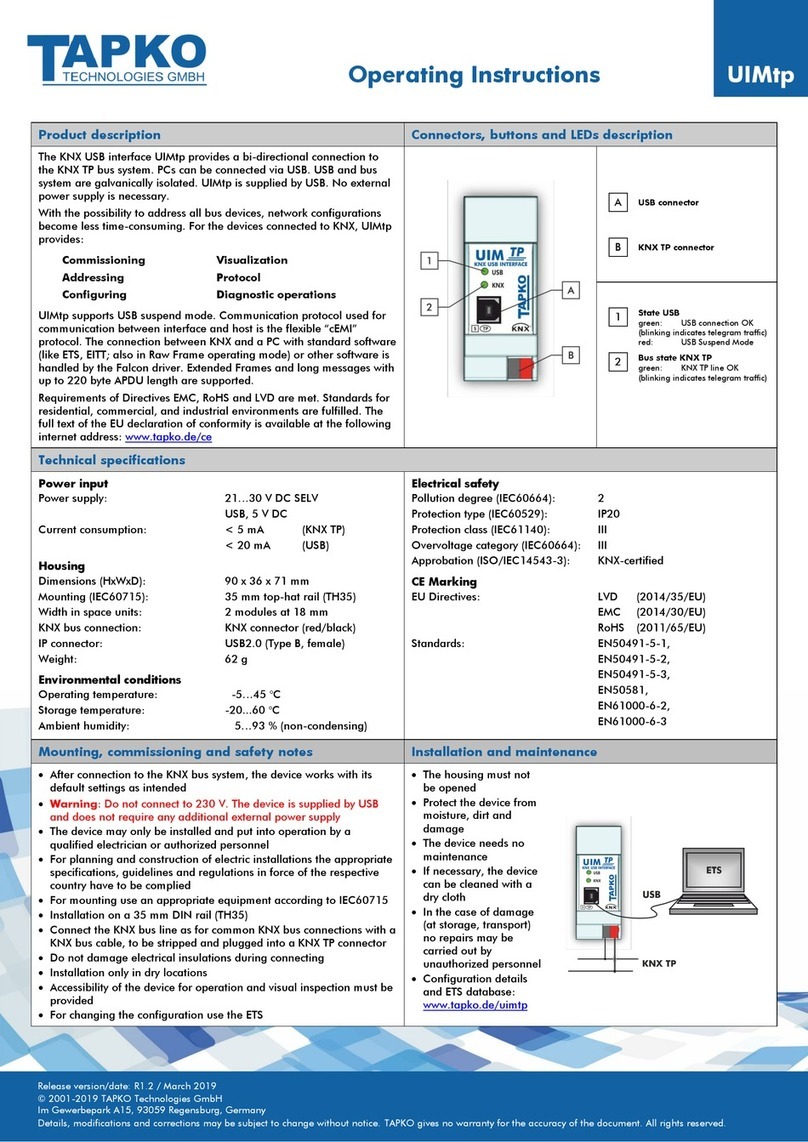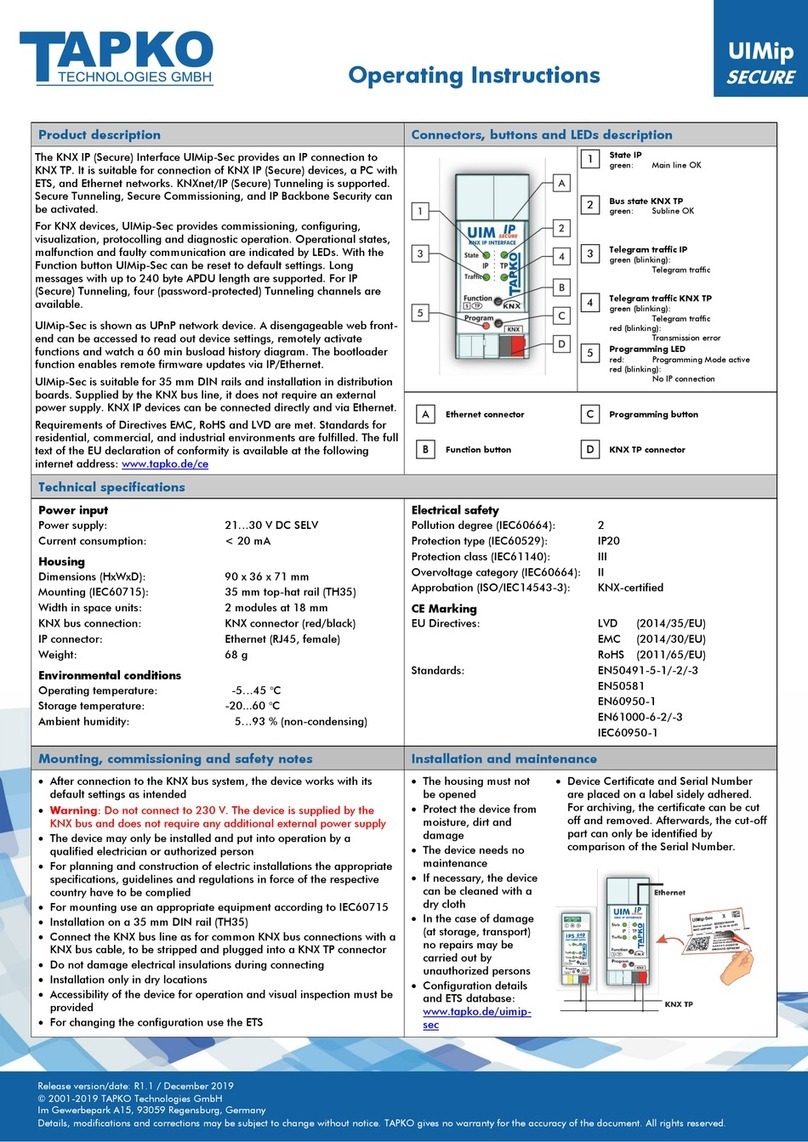TAPKO TAI4 User manual

Operating Instructions
TAI4
TECHNOLOGIES GMBH
Release version/date: R1.1 / October 2019
© 2001-2019 TAPKO Technologies GmbH
Im Gewerbepark A15, 93059 Regensburg, Germany
Details, modifications and corrections may be subject to change without notice. TAPKO gives no warranty for the accuracy of the document. All rights reserved.
Product description
Connectors, buttons and LEDs description
The TAI4 Contact Interface is a 4-fold KNX binary input to sensor
contacts and to control/switch/operate KNX devices via classical
conventional switches and push buttons. The input module is suitable to
process binary signals of potential-free contacts. Due to its small
housing (diagonal of 50 mm) TAI4 finds enough room in a flush-
mounted box (Ø 60 mm) behind the switch. The connecting cable pairs
of 28 cm can be extended up to 10 m when twisted.
Designed for potential-free contacts such as conventional switches,
contact sensors and push buttons, TAI4 provides a 3.3 V sensing voltage
for contact scanning. All usual input functions like switching, dimming,
shutters, blinds control, counter and scenes can be used in a common
way.
Requirements of Directives EMC, RoHS and LVD are met. Standards for
residential, commercial, and industrial environments are fulfilled. The
full text of the EU declaration of conformity is available at the following
internet address: www.tapko.de/ce
Input
Programming button
Programming LED
red: Programming Mode
active
KNX TP connector
Technical specifications
Power input
Power supply:
Current consumption:
Housing
Dimensions (HxWxD):
Flush mounting:
KNX bus connection:
Input cables:
Weight:
Inputs
Potential-free contacts:
Sensing voltage:
Sensing current:
21…30 V DC SELV
< 10 mA
43 x 42 x 11 mm
Box of Ø 60 mm x 40 mm
KNX connector (red/black)
4 pairs of 28 cm length
0.22 mm2(Ø 0.56 mm)
22 g
4
3.3 V
0.3 mA (100 mA short-time)
Environmental conditions
Operating temperature:
Storage temperature:
Ambient humidity:
Electrical safety
Pollution degree (IEC60664):
Protection type (IEC60529):
Protection class (IEC61140):
Overvoltage category (IEC60664):
Approbation (ISO/IEC14543-3):
CE Marking
EU Directives:
Standards:
-5…45 °C
-25...70 °C
5…93 % (non-condensing)
2
IP20
III
III
KNX-certified
LVD (2014/35/EU)
EMC (2014/30/EU)
RoHS (2011/65/EU)
EN50491-2, EN50491-5-1,
EN50491-5-2, EN50491-5-3
EN50581
Mounting, commissioning and safety notes
Installation and maintenance
•After connection to the KNX bus system, the device works with its
default settings as intended
•Warning: Do not connect to 230 V. The device is supplied by the
KNX bus and does not require any additional external power supply
•The device may only be installed and put into operation by a
qualified electrician or authorized person
•For planning and construction of electric installations the appropriate
specifications, guidelines and regulations in force of the respective
country have to be complied
•The device must not be mounted in a box together with 230 V devices
and/or 230 V cables
•Combinations of a push button device connected to both the TAI4
and a 230 V device (or sockets) at the same time are not allowed
•Ensure that there is a safety separation (SELV) between connected
signal cables (including extensions) and other current and voltage
carrying devices and cables
•When connecting the TAI4, ensure that it can be isolated
•Prevailing safety and accident prevention rules must be heeded
•Connect the KNX bus line as for common KNX bus connections with a
KNX bus cable, to be stripped and plugged into a KNX TP connector
•Do not damage electrical insulations during connecting
•For changing the configuration use the ETS
•The housing must not be opened
•Installation only in dry locations
•Accessibility of the device for operation and visual inspection must be
provided
•Protect the device from moisture, dirt and damage
•The device needs no maintenance
•If necessary, the device can be cleaned with a dry cloth
•In the case of damage (at storage, transport) no repairs may be
carried out by unauthorized persons
•Configuration details and ETS database: www.tapko.de/tai4
A
B
C
D

Betriebs-/Montageanweisung
TAI4
TECHNOLOGIES GMBH
Version/Veröffentlichung: R1.1 / Oktober 2019
© 2001-2019 TAPKO Technologies GmbH
Im Gewerbepark A15, 93059 Regensburg, Germany
Hier enthaltene Daten können sich ohne vorherige Ankündigung ändern. TAPKO garantiert nicht die Richtigkeit und Vollständigkeit des Dokuments. Alle Rechte vorbehalten.
Produktbeschreibung
Anschlüsse, Tasten und LEDs
Die Kontakt-Schnittstelle TAI4 kann als 4-facher Binäreingang
verwendet werden. Ideal sowohl zur Zustandserkennung von
Kontaktsensoren als auch zum Steuern/Schalten/Regeln von KNX-
Busteilnehmern mit klassischen konventionellen Schaltern und Tastern.
Die Eingänge sind geeignet für potentialfreie Kontakte. Aufgrund des
kleinen Gehäuses (50 mm diagonal) findet die TAI4 in einer
Unterputzdose (Ø 60 mm) genügend Platz hinter dem Schalter. Die
Kabelpaare der Eingänge können verdrillt von 28 cm auf bis zu 10 m
verlängert werden.
Für potentialfreie Kontakte wie Kontaktsensoren, konventionelle
Schalter und Taster stellt die TAI4 eine Abfragespannung von 3,3 V zur
Kontakterkennung bereit. Alle typischen KNX-Funktionen wie Schalten,
Dimmen, Rollläden-/Jalousiesteuerung, Zähler und Szene stehen zur
Verfügung.
Die Anforderungen der Direktiven EMC, RoHS und LVD sowie Standards
für Wohn & Gewerbebereiche als auch Industriebereiche werden erfüllt.
Der vollständige Text der EU-Konformitätserklärung ist unter der
folgenden Internetadresse verfügbar: www.tapko.de/ce
Eingänge
Programmiertaste
Programmier-LED
rot: Programmier-Modus an
KNX TP Anschluss
Technische Angaben
Versorgung
Eingangsspannung:
Stromverbrauch:
Gehäuse
Maße (HxBxT):
Unterputzmontage:
KNX Bus-Anschluss:
Ein-/Ausgang-Kabel:
Gewicht:
Eingänge
Potentialfreie Kontakte:
Abfragespannung:
Abfragestrom:
21…30 V DC SELV
< 10 mA
43 x 42 x 11 mm
(Ø 60 mm x 40 mm)-Dose
KNX Klemme (rot/schwarz)
4 Kabelpaare, 28 cm lang
0,22 mm2(Ø 0,56 mm)
22 g
4
3,3 V
0,3 mA (100 mA kurzzeitig)
Umgebungsbedingungen
Arbeitstemperatur:
Lagertemperatur:
Umgebende Feuchte:
Elektrische Sicherheit
Verschmutzungsgrad (IEC60664):
Schutzart (IEC60529):
Schutzklasse (IEC61140):
Überspannungskategorie (IEC60664):
Freigabe (ISO/IEC14543-3):
CE Kennzeichnung
EU Direktiven:
Standards:
-5…45 °C
-25...70 °C
5…93 % (nicht-kondens.)
2
IP20
III
III
KNX-zertifiziert
LVD (2014/35/EU)
EMC (2014/30/EU)
RoHS (2011/65/EU)
EN50491-2, EN50491-5-1,
EN50491-5-2, EN50491-5-3
EN50581
Montage, Inbetriebnahme und Sicherheit
Installation und Wartung
•Nach Anschluss an das KNX-Bussystem arbeitet das Gerät mit seinen
Standardeinstellungen wie vorgesehen
•Warnung: Nicht an 230V anschließen. Das Gerät wird vom KNX-Bus
versorgt und benötigt keine zusätzliche externe Stromversorgung
•Das Gerät darf nur von einer Elektrofachkraft oder autorisiertem
Fachpersonal installiert und in Betrieb genommen werden
•Bei der Planung und Errichtung von elektrischen Anlagen sind die
einschlägigen Richtlinien, Vorschriften und Bestimmungen des
jeweiligen Landes zu beachten
•Das Gerät darf nicht in einer Box zusammen mit 230 V-Geräten
und/oder 230 V-Kabel montiert werden
•Kombinationen, bei denen Taster gleichzeitig an die TAI4 und an ein
230 V-Gerät (bzw. Steckdose) angeschlossen sind, sind nicht erlaubt
•Eine sichere Trennung (SELV) zwischen angeschlossenen Signalkabeln
(einschließlich Erweiterungen) und anderen Strom und Spannung
führenden Geräten und Kabeln muss gewährleistet sein
•Beim Anschließen dafür sorgen, dass die TAI4 isoliert werden kann
•Geltende Sicherheits- und Unfallverhütungsvorschriften beachten
•Die KNX-Buslinie, wie für alle üblichen KNX-Anschlüsse, mit
abisoliertem KNX-Buskabel und KNX TP-Klemme anschließen
•Beim Anschließen nicht die elektrischen Isolationen beschädigen
•Änderungen an der Konfiguration mit der ETS vornehmen
•Das Gehäuse darf nicht geöffnet werden
•Installation nur bei trockener Umgebung
•Die Zugänglichkeit zum Gerät muss aus Gründen der Bedienbarkeit
und Inspektion stets gewährleistet sein
•Gerät vor Feuchtigkeit, Schmutz und Beschädigung schützen
•Das Gerät ist wartungsfrei
•Wenn nötig, das Gerät mit einem trockenen Tuch reinigen
•Bei Beschädigung (bei Transport, Lagerung) darf keine Reparatur
vorgenommen werden; Gerät zurückschicken
•Konfiguration-Details und ETS-Datenbank: www.tapko.de/tai4
A
B
C
D
Table of contents
Languages:
Other TAPKO Recording Equipment manuals




















